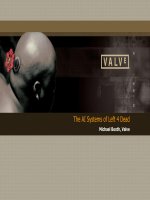Physiology: The digestive system
Bạn đang xem bản rút gọn của tài liệu. Xem và tải ngay bản đầy đủ của tài liệu tại đây (1.68 MB, 70 trang )
Physiology
The Digestive
System
www.cambodiamed.com
Functions of the GI Tract
Motility:
• Movement of of food through the GI tract.
• Ingestion:
• Taking food into the mouth.
• Mastication:
• Chewing the food and mixing it with saliva.
• Deglutition:
• Swallowing the food.
• Peristalsis:
• Rhythmic wave-like contractions that move food through
GI tract.
www.cambodiamed.com
Functions of the GI Tract
(continued)
• Secretion:
• Includes both exocrine and endocrine secretions.
• Exocrine:
• HCl, H20, HC03-, bile, lipase, pepsin, amylase, trypsin, elastase, and
histamine are secreted into the lumen of the GI tract.
• Endocrine:
• Stomach and small intestine secrete hormones to help regulate the GI
system.
• Gastrin, secretin, CCK, GIP, GLP-1, guanylin, VIP, and
somatostatin.
www.cambodiamed.com
Functions of the GI Tract
(continued)
• Digestion:
• Breakdown of food particles into subunits (chemical
structure change).
• Absorption:
• Process of the passage of digestion (chemical subunits)
into the blood or lymph.
• Storage and elimination:
• Temporary storage and elimination of indigestible
food.
www.cambodiamed.com
Digestive System (GI)
• GI tract divided
into:
Insert fig. 18.2
• Alimentary
canal.
• Accessory
digestive organs.
• GI tract is 30 ft
long and extends
from mouth to
anus.
www.cambodiamed.com
Layers of GI Tract
• Composed of 4 tunics:
• Mucosa.
• Submucosa.
Muscularis.
Serosa.
www.cambodiamed.com
Mucosa
• Lines the lumen of GI tract.
• Consists of simple columnar epithelium.
• Lamina propria:
• Thin layer of connective tissue containing lymph
nodules.
• Muscularis mucosae:
• Thin layer of smooth muscle responsible for the folds.
• Folds increase surface area for absorption.
• Goblet cells:
• Secrete mucus.
www.cambodiamed.com
Submucosa
• Thick, highly vascular layer of connective tissue.
• Absorbed molecules enter the blood and
lymphatic vessels.
• Submucosal plexus (Meissner’s plexus):
• Provide autonomic nerve supply to the muscularis
mucosae.
www.cambodiamed.com
Muscularis
• Responsible for segmental contractions and
peristaltic movement through the GI tract.
• Inner circular layer of smooth muscle.
• Outer longitudinal layer of smooth muscle.
• Contractions of these layers move food through
the tract; pulverize and mix the food.
• Myenteric plexus located between the 2 muscle
layers.
• Major nerve supply to GI tract.
• Fibers and ganglia from both sympathetic and
parasympathetic nervous systems.
www.cambodiamed.com
Serosa
• Binding and protective outer layer.
• Consists of areolar connective tissue covered with
simple squamous epithelium.
www.cambodiamed.com
Regulation of the GI Tract
• Extrinsic innervation:
• Parasympathetic nervous system:
• Vagus and spinal nerves:
• Stimulate motility and GI secretions.
• Sympathetic nervous system:
• Postganglionic sympathetic fibers that pass through
submucosal and myenteric plexuses and innervate GI tract:
• Reduce peristalsis and secretory activity.
www.cambodiamed.com
Regulation of the GI Tract
(continued)
• Enteric nervous system:
• Sites where parasympathetic fibers synapse with
postganglionic neurons that innervate smooth muscle.
• Submucosal and myenteric plexuses:
• Local regulation of the GI tract.
• Paracrine secretion:
• Molecules acting locally.
• Hormonal secretion:
• Secreted by the mucosa.
www.cambodiamed.com
From Mouth to Stomach
• Mastication (chewing):
• Mixes food with saliva which contains salivary amylase.
• Enzyme that can catalyze the partial digestion of starch.
• Deglutition (swallowing):
• Begins as a voluntary activity.
• Involves 3 phases:
• Oral phase is voluntary.
• Pharyngeal and esophageal phases are involuntary.
• Cannot be stopped.
• Larynx is raised.
• Epiglottis covers the entrance to respiratory tract.
www.cambodiamed.com
From Mouth to Stomach
(continued)
• Involuntary muscular contractions and relaxations
in the mouth, pharynx, larynx, and esophagus are
coordinated by the swallowing center in the
medulla.
• Esophagus:
• Connects pharynx to the stomach.
• Upper third contains skeletal muscle.
• Middle third contains a mixture of skeletal and smooth
muscle.
• Terminal portion contains only smooth muscle.
www.cambodiamed.com
Esophagus
• Peristalsis:
• Produced by a series of
localized reflexes in response
to distention of wall by bolus.
Insert 18.4a
• Wave-like muscular
contractions:
• Circular smooth muscle
contract behind, relaxes in
front of the bolus.
• Followed by longitudinal
contraction (shortening) of
smooth muscle.
• Rate of 2-4 cm/sec.
• After food passes into
stomach, LES constricts.
www.cambodiamed.com
Stomach
• Most distensible part of GI tract.
• Empties into the duodenum.
• Functions of the stomach:
• Stores food.
• Initiates digestion of proteins.
• Kills bacteria.
• Moves food (chyme) into intestine.
www.cambodiamed.com
Stomach
• Contractions of
the stomach
churn chyme.
• Mix chyme
with gastric
secretions.
• Push food
into intestine.
(continued)
Insert fig. 18.5
www.cambodiamed.com
Stomach
(continued)
• Gastric mucosa
has gastric pits in
the folds.
• Cells that line the
folds deeper in
the mucosa, are
gastric glands.
Insert fig. 18.7
www.cambodiamed.com
Gastric Glands
• Secrete gastric juice:
•
•
•
•
Goblet cells: mucus.
Parietal cells: HCl and intrinsic factor.
Chief cells: pepsinogen.
Enterochromaffin-like cells (ECL): histamine and
serotonin.
• G cells: gastrin.
• D cells: somatostatin.
• Stomach: ghrelin.
www.cambodiamed.com
HCl Production
• Parietal cells secrete
H+ into gastric lumen
by primary active
transport, through
H+/ K+ ATPase
pump.
Insert fig. 18.8
• Parietal cell’s
basolateral
membrane takes in
Cl- against its
electrochemical
gradient, by
coupling its
transport with
HC03-.
www.cambodiamed.com
HCl Production
(continued)
• HCl production is stimulated:
• Indirectly by gastrin.
• Indirectly by ACh.
• ACh and gastrin stimulate release of histamine.
• Histamine:
• Stimulates parietal cells to secrete HCl.
www.cambodiamed.com
HCl Functions
• Makes gastric juice
very acidic.
Insert fig. 18.9
• Denatures ingested
proteins (alter
tertiary structure) so
become more
digestible.
• Activates
pepsinogen to
pepsin.
• Pepsin is more
active at pH of 2.0.
www.cambodiamed.com
Digestion and Absorption in the
Stomach
• Proteins partially digested by pepsin.
• Carbohydrate digestion by salivary amylase is
soon inactivated by acidity.
• Alcohol and aspirin are the only commonly
ingested substances absorbed.
www.cambodiamed.com
Gastric and Peptic Ulcers
• Peptic ulcers:
• Erosions of the mucous membranes of the stomach or duodenum
produced by action of HCl.
• Zollinger-Ellison syndrome:
• Ulcers of the duodenum are produced by excessive gastric acid
secretions.
• Helicobacter pylori:
• Bacterium that resides in GI tract that may produce ulcers.
• Acute gastritis:
• Histamine released by tissue damage and inflammation stimulate
further acid secretion.
www.cambodiamed.com
Protective Mechanisms of Stomach
• Parietal and chief cells impermeable to HCl.
• Alkaline mucus contains HC03-.
• Tight junctions between adjacent epithelial cells.
• Rapid rate of cell division (entire epithelium
replaced in 3 days).
• Prostaglandins inhibit gastric secretions.
www.cambodiamed.com









